Discover the historical and cultural magic of Cusco, the ancestral city once the jewel of the Inca Empire. Walking through its cobblestone streets is to delve into a glorious past, where the relics of Inca greatness blend with colonial heritage.
Exploring the local museums is essential to fully appreciating the richness of this legacy. In these knowledge sanctuaries, a captivating panorama unfolds before your eyes, ranging from the grandeur of the Inca civilization to colonial influence and the region’s natural diversity.
Below is a list of museums you cannot miss when visiting Cusco. These are places where you can connect with the magic of the past and the Inca culture.
Museum of religious art
The “Museo de Arte Religioso del Cusco”, located in the Archbishop’s Palace, houses an impressive collection of colonial art, including canvases, sculptures, carvings, altarpieces, and religious furniture. Built on the foundations of an ancient Inca palace, the museum offers a fascinating journey through the history and art of Cusco.
History of the Museum:
Built on the foundations of the palace of Inca Roca, the sixth Inca ruler, a portion of the original structure was demolished to make way for the residence of the first bishop of Cusco, Fray Vicente Valverde. Over the 20th century, this emblematic building underwent a metamorphosis to become the Archbishop’s Palace.
Architecture:
- Impressive colonial Baroque architecture.
- It is built in stone and has columns, bay windows, courtyards, pools, and beautifully decorated arches.
- Walls that retain their Inca stone structure.
- Symbols of the different stages of Cusco: pre-Inca, Inca, colonial, and modern.
Collection:
- More than 200 colonial canvases with religious themes.
- Works by renowned artists of the Cusco School, such as Diego Quispe Tito.
Highlighted pieces:
- “The Virgin of the Milk” (anonymous)
- “Christ Crucified” (anonymous)
- Diego Quispe Tito Room: 12 canvases on the Corpus Christi festival
- Church chapel: Baroque altarpiece adorned in gold leaf
- Golden Hall
Location:
- Hatun Rumiyoc Street is just steps from the Plaza de Armas of Cusco.
- The Stone of the 12 Angles, a famous Inca structure, is part of the complex.
Hours:
- Monday to Saturday: 8:00 am to 6:00 pm
- Sundays: Closed
Price:
- Approximately 30 soles (8 USD)
Tips:
- No photography is allowed inside the museum.
- Specialized guides are available for an additional cost.
- Visit other churches and temples in Cusco to appreciate colonial art, such as the Church of San Pedro, Santo Domingo, San Francisco, Santa Ana, La Merced, and the Church of the Society of Jesus.
- Entry to these churches is free during Mass (usually on Sunday mornings).
The museum is integral to the Religious Circuit, which includes the Church of San Blas, the Church of San Cristóbal, and the Cathedral of Cusco. You can walk from the Plaza de Armas or take a taxi to the museum.

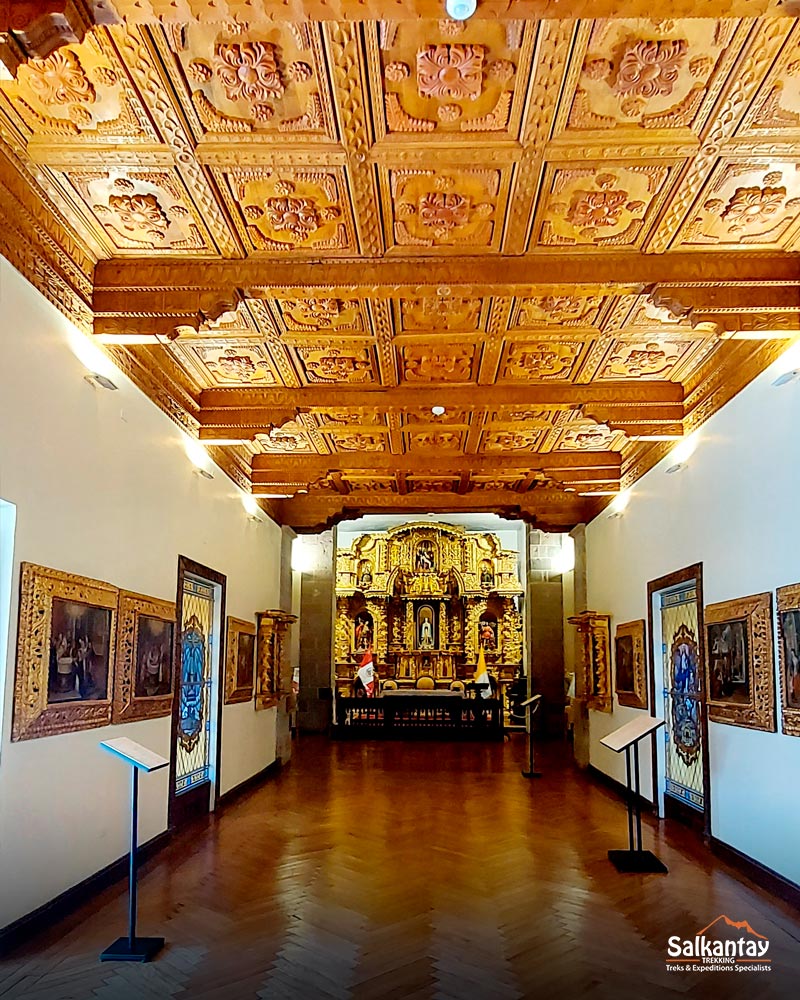
Museum of the Monastery of Saint Catherine of Siena
Museum of the Monastery of Santa Catalina de Siena
With a history dating back to 1601 in Arequipa, founded by Doña Lucía Rivera de Padilla, the Monastery of Santa Catalina de Siena has witnessed centuries of transformations and challenges. Transferred to Cusco in 1605 due to natural disasters, this monastery has been home to contemplative Dominican nuns since its establishment.
Recognized as one of Cusco’s three oldest cloistered nun communities, the monastery has maintained its presence and influence over the centuries. Even during the republican era, the monastery continued its uninterrupted operation, serving as a refuge of spirituality and tradition amidst political and social changes. Its legacy is a living testimony to the faith and devotion that have characterized this institution throughout its long and rich history.
Location:
- 401 Arequipa Street, Cusco.
Attractions:
- Colonial architecture: Late Renaissance style with Roman arches.
- Paintings: Cusco School of the 17th and 18th centuries.
- Tapestries: Huge tapestries from the colonial period.
- Chapter room: Admirable for its colorful colonial paintings.
Monastic Life Museum:
- Exhibits goldsmithing, textiles, sculptures, and altarpieces.
- Canvases by anonymous authors, including “The Lord of the Tremors.”
- Collection on the life and miracles of Santa Rosa de Lima.
- Liturgical objects, murals, carvings, gold, and silversmithing.
- Chapel with representation of flora from the Inca worldview.
- Chest with a model of the life of Christ used for evangelization.
- Extensive exhibition on monastic life within the convent.
Hours:
- Monday to Saturday: 8:30 am to 5:30 pm.
- Sunday: 2:00 pm to 5:00 pm.
Price:
- Adults: S/ 8.00
- Students: S/ 4.00
- Approximately 18 dollars for foreigners
In addition to being a historical and spiritual treasure, the Monastery of Santa Catalina de Siena is an essential stop on the Religious Circuit of Cusco. Located within the Plaza de Armas, visitors can enjoy a pleasant walk or taxi to the monastery.
It is important to note that, out of respect for the contemplative life of the nuns, photography is not allowed inside the facilities. However, tourists can participate in guided tours available in Spanish and English, which offer an enriching experience in exploring the history and architecture of this venerable place of worship.
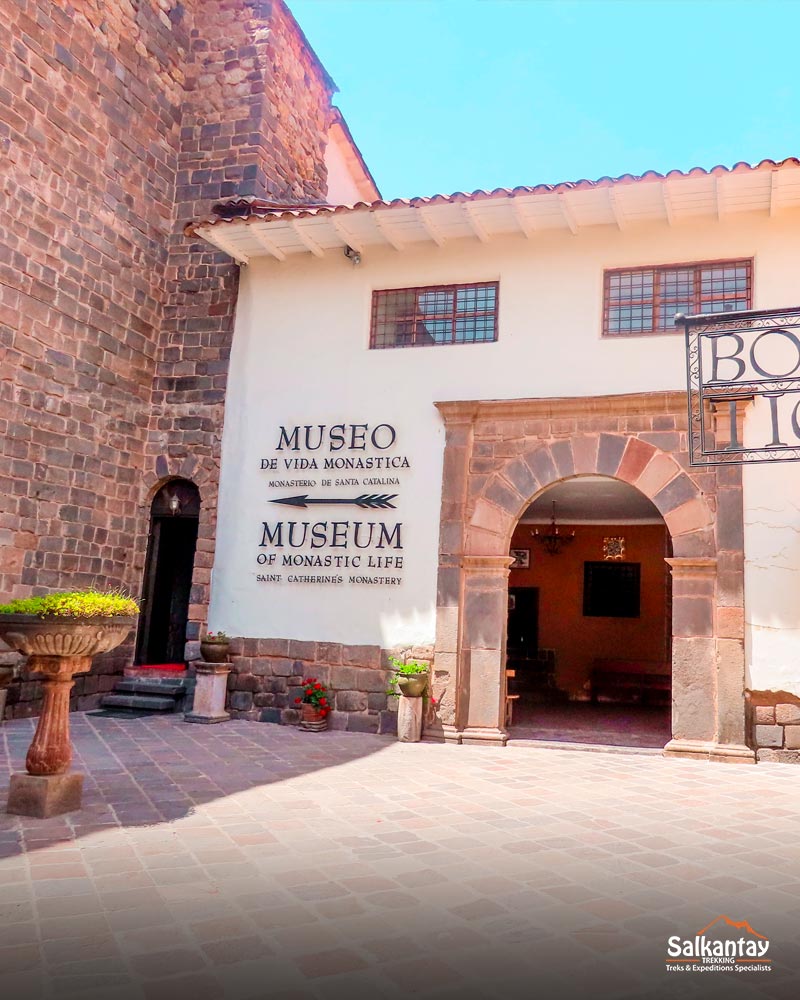
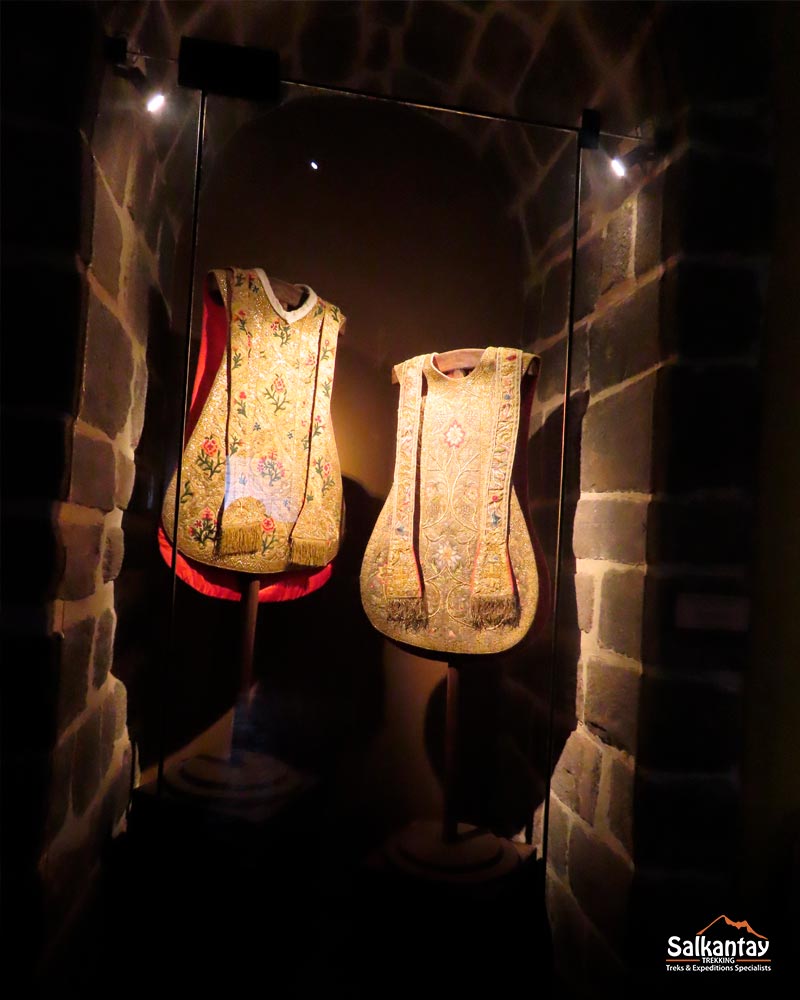
Cusco Cathedral Museum
The majestic Cusco Cathedral, considered one of South America’s most significant architectural treasures, has its roots deeply embedded in Peru’s colonial history. Its construction dates back to 1536, shortly after the arrival of the Spanish in the region. By order of Francisco Pizarro, the cathedral was erected on the foundations of the palace of Inca Viracocha, thus marking a turning point in the transformation of Cusco’s urban landscape. This monumental project was driven by the genuine ambition of Spanish conquistadors to leave their mark on the newly discovered land.
A crucial milestone in the cathedral’s history was the appointment of Fray Vicente de Valverde as the first bishop of Cusco and, consequently, of South America. His appointment symbolized the consolidation of ecclesiastical power in the region and established a direct link between the Diocese of Cusco and the bishopric of Seville in Spain. This connection with the center of Hispanic Christianity influenced local religious administration and left an indelible mark on the culture, architecture, and identity of colonial Cusco. The cathedral thus became a beacon of Catholic faith in the New World, projecting the influence and prestige of the Church throughout the Andean region.
Location:
- Plaza de Armas del Cusco, next to the Church of the Holy Family and the Church of the Triumph.
Architecture:
- Renaissance style on the facade, Baroque, late Gothic, and Plateresque styles inside.
- Rectangular floor plan with three naves: epistle, central, and gospel.
- Fourteen cross-shaped pillars supporting 24 ribbed vaults.
- Andesite stone facade with three portals.
Adjacent churches:
- Church of the Holy Family: Built between 1723 and 1735, it was the city’s first cemetery.
- Church of the Triumph: Cusco’s first Church, built in 1539 on the palace of Wiracocha, is where the remains of Inca Garcilaso de la Vega lie.
Pictorial art:
- Baroque style influence from the 17th century onward.
- Works by Diego Quispe Tito, Basilio Santa Cruz Pumacallao, Bernardo Bitti, and Mateo Pérez de Alesio stand out.
- Three famous pictorial collections:
- Our Lady of Almudena (1698) by Basilio Santa Cruz Pumacallao
- Series of Lauretan Litanies (1755) by Marcos Zapata
- Virgin of the Little Bird (16th century) by Bernardo Demócrito Bitti
Sculptures:
- Baroque and Renaissance style, with realism and human proportions.
- Cedarwood, maguey, and other materials.
- Figures of Saints, Virgins, and Christ.
- Central sculpture: “Lord of the Tremors” or “Black Christ,” patron saint of Cusco.
- Other notable sculptures are the Carving of Archangel Michael, the Virgin of the Immaculate Conception (“La Linda”), choir stalls, the main altar of the Church of the Holy Family, and the Triumph pulpit.
Treasures:
- Image of the Black Christ and the Last Supper by Marco Zapata Sinchi Roqa with a guinea pig.
- Variety of high-value items: gold, gemstones, and silver.
- Two hundred fifty-six ornaments or metallic objects of different sizes.
- Silverware chapel: holy water font, candelabra, lamps, custody made by Gregorio Gallegos in 1745 (1.20 meters high, 27 kilograms, with pearls, rubies, and emeralds).
Details:
- Location: Eastern part of the Plaza de Armas
- Hours: Monday to Sunday from 10:00 am to 6:00 pm.
- Price:
- Adults (National or Foreign): 40 Peruvian Soles (10 USD)
- Students (National or Foreign): 20 Peruvian Soles (With valid ISIC card), (5 USD)
Tips:
- Buy tickets in advance.
- Wear comfortable clothes and shoes, as a lot of walking is involved.
- Respect cathedral rules: silence, appropriate attire, no photography in some areas.
- Hire a guided tour to delve deeper into the cathedral’s history and art.


Pre-Columbian Art Museum
The BBVA Peru Museum, the result of a collaboration between the BBVA Peru Foundation and the Larco Museum of Lima, has a fascinating history dating back to the times of the ancient Casa Cabrera. This building, with a rich history spanning from its original function as an Inca “yachaywasi,” a place of wisdom and knowledge, to its use as the convent of Santa Clara and later as the residence of Don Jerónimo Luis de Cabrera y la Cerda, has witnessed centuries of transformations and events.
In 1981, BBVA Peru acquired this historic property and carried out an ambitious restoration to turn it into the home of the museum we know today. This restoration process not only preserved the building’s original architecture and historical character but also adapted it to properly house the valuable collections and exhibitions that are part of Peru’s cultural heritage.
Thus, the BBVA Peru Museum stands as a meeting point between the past and the present, a space where history comes to life through art and culture, offering visitors an enriching and memorable experience.


Description:
- Exhibits pre-Columbian art from Peru from the 9th century BCE to the 16th century CE.
- Selected pieces from a universe of 45,000 objects from the Rafael Larco Herrera Archaeological Museum of Lima.
- There are 11 rooms that trace the evolution of pre-Columbian art: wood, Nazca, Mochica, Hui, Chimú, inca, Viceregal, Gold, and Silver.
Attractions:
- Four hundred three works of art spanning 2772 years of history.
- Modern museography that highlights the beauty of the pieces.
- Training Room: Displays art from cultures such as Salinar, Cupisnique, Viru, Vicus, and Paracas.
- Gold and Silver Room: Exhibits impressive works in these precious metals.
Information:
- Hours: Monday to Sunday from 9:00 am to 10:00 pm.
- Price: General admission S/ 20.00 (5 USD) – Students S/ 10.00
- Address: Plazoleta Nazarenas 231, Cusco, Peru
The Museum Gallery:
- H.Stern: 18-carat gold jewelry inspired by pre-Columbian pieces.
- Alpaca 111: High-quality alpaca and vicuña clothing and textiles.
- Map Café: This restaurant is where you can enjoy coffee and Peruvian cuisine.
Tips:
- Buy tickets in advance, especially in high season.
- Wear comfortable clothes and shoes.
- Respect the museum’s rules: silence, appropriate attire, no photography in some areas.
- Hire a guided tour to delve deeper into the museum’s history and art.
The Pre-Columbian Art Museum Cusco is a must-visit for any art and history lover. It is a place where you can immerse yourself in the cultural richness of ancient Peru and admire masterpieces that have survived the test of time.


Inka Museum
Are you passionate about Inca culture? Then, the Inca Museum of Cusco, also known as the Archaeological Museum of the National University of San Antonio Abad (UNSAAC), is a must-visit on your trip. Located in a colonial mansion once the palace of Inca Huáscar and later the residence of Admiral Alderete Maldonado, this museum houses an impressive collection of archaeological pieces that will transport you to the time of the Tahuantinsuyo.

Why visit the Inca Museum?
- It gathers one of the most comprehensive collections of Inca art in the world: Admire ceramics, textiles, ceremonial vessels (queros), works in gold and silver, weapons of war, mummies, and much more.
- Discover Cusco’s history from pre-Inca times to the 20th century: Explore the museum’s halls and learn about the development of cultures such as Chavín, Marcavalle, Nazca, Wari, and Inca.
- Admire the museum’s colonial architecture: The “House of the Admiral” is a beautiful example of Cusco’s colonial architecture, with its coffered ceilings, courtyards, and gardens.
- Attend temporary exhibitions: The museum presents exhibitions by Cusco artists showcasing their talent in stone carving, textiles, ceramics, and more.
What will you find in the museum?
- This is a chronological journey through pre-Inca cultures and the Inca Empire, from the earliest hunter-gatherers to the height of the Tahuantinsuyo.
- Unique pieces include the largest collection of queros in the world and Inca ceremonial vessels decorated with elaborate designs.
- A recreation of an Inca tomb or “Mallki Wasi”: Discover how the Incas were buried and the offerings that accompanied their deceased.
- Exhibitions on the environment and Inca subsistence techniques: Appreciate the importance of these aspects for Inca culture.
Practical information:
- Location: Cuesta del Almirante 103, Cusco (a few steps from the Plaza de Armas).
- Hours: Monday through Friday, 8:00 am to 6:00 pm, and Saturdays and Sundays, 9:00 am to 4:00 pm.
- Price: Foreigners: S/ 10.00 (3 USD)| Peruvians: S/ 5.00
Additional tips:
- Hire a tour guide: They will provide a more detailed explanation of the pieces and the historical context.
- Wear comfortable clothes and shoes: You will walk through the museum’s rooms.
- Respect the museum’s rules: No photography or touching the pieces.
- Plan your visit: The museum tends to have quite a crowd.
The Inca Museum of Cusco is a unique cultural experience that will allow you to delve deep into the fascinating history of the Inca Empire. Take advantage of the opportunity to immerse yourself in this world of treasures and traditions.


Contemporary Art Museum
Explore the fascinating universe of contemporary Cusco art through a visit to the Contemporary Art Museum, strategically located in the heart of the imperial city. Since its establishment in 1995, this museum has become a reference point for those wishing to explore the rich artistic diversity of the region.
With an impressive collection of over 280 works by contemporary and classic artists, both local and international, the Contemporary Art Museum offers an immersive experience that celebrates creativity in all its forms.
From vibrant paintings to provocative installations, each exhibited work tells a unique story and reflects the cultural diversity and artistic vitality that characterize the city of Cusco. It is a dynamic space where the past and present intertwine in a continuous dialogue, allowing visitors to reflect, be inspired, and connect with art on a deeper level.
What will you find in the museum?
- A journey through the history of Cusco art: From colonial times to the present day, you can appreciate the region’s evolution of style and artistic techniques.
- Works by renowned artists: Highlights include the presence of artists such as Edilberto Mérida, Antonio Olave, Hilario Mendívil, and many more, representatives of the talented San Blas neighborhood.
- Temporary exhibitions: The museum continuously presents new exhibitions by local and international contemporary artists.
- Cusco handicrafts: In addition to the artworks, there is a permanent exhibition of traditional Cusco handicrafts crafted by talented local artists.
How to get there?
The Contemporary Art Museum is in the Municipal Palace of Cusco, right in front of the Plazoleta de Regocijo, just a few steps from the Plaza de Armas. If you are outside the Historic Center, you can walk or take a taxi.
Practical information:
- Location: Municipal Palace of Cusco, Plaza de Armas.
- Hours: Monday to Saturday from 9:00 am to 6:30 pm.
- Price: Admission is included in the Cusco Tourist Ticket 2 (S/ 70.00, 18 USD).
Additional tips:
- Purchase the Cusco Tourist Ticket 2: It allows you to access this museum and other important archaeological and cultural sites in the city.
- Visit the temporary exhibitions: They are an excellent way to learn about the latest trends in contemporary art in Cusco.
- Buy Cusco handicrafts: The museum is an excellent place to buy authentic, high-quality souvenirs.
- Acclimate to the altitude: Cusco is at a considerable altitude (3,399 meters above sea level), so it is essential to acclimate before engaging in physical activities. Drink plenty of water and coca tea to prevent altitude sickness.
The Contemporary Art Museum of Cusco is a must-visit destination for those who appreciate art and culture. This space invites you to immerse yourself in the rich artistic expression of the imperial city, where you will have the opportunity to discover the talent and creativity of local and regional artists.


Convent of the Temple of San Francisco Museum
Discover the impressive grandeur of Cusco by exploring the magnificent Church and Convent of San Francisco. This monumental complex, dating back to colonial times, immerses you in a journey through time, awing you with its imposing architecture, sublime art, and rich history.
The majesty of this sacred place, where every corner tells a fascinating story and every architectural detail reflects the skill and vision of artisans of yesteryears. This experience will transport you to an era of splendor and devotion, leaving you amazed by the beauty and timeless charm of this emblematic site of colonial Cusco.
What will you find in this Cusco treasure?
- A church of simple yet imposing style: Admire its unique tower with a bell tower and its single-nave interior with a Latin cross-shaped platform.
- A Renaissance convent with cloisters, gardens, and catacombs: Walk through its halls full of history and discover the crypts where the remains of members of the Franciscan order rest.
- Works of art from the Cusco School: Diego Quispe Tito’s canvases, such as “The Last Judgment” and “Paradise, Purgatory, and Hell,” will captivate you.
- The “Genealogical Tree of the Franciscan Order”: Marvel at this masterpiece 12 meters high and 9 meters wide, the largest oil painting in South America and the third largest in the world.
- A harmonious and silent environment: Enjoy the tranquility of its gardens and corridors, an oasis of peace in the heart of Cusco.
Where is it located?
Just a few steps from the Plaza de Armas, in the Plaza San Francisco that bears its name, this Cusco icon awaits you to be discovered.
How to get there?
You can walk from the Plaza de Armas or any point in the Historic Center. Most tourist hotels are located in this area, making access easy.
A bit of history
After the Spanish conquest, the Franciscans arrived in Cusco in the 16th century to build an evangelizing temple. Initially located in San Blas, it was moved to the Plaza de Armas on the Inca palace of Qasana. Finally, in 1559, its current location was defined. Construction extended between 1572 and 1652 (after the earthquake of 1650).
Architecture:
- Church: Simple, with a single tower and bell tower. The interior of a nave has a platform shaped like a Latin cross and a Plateresque facade.
- Convent: Renaissance style, with cloisters, gardens, catacombs, and coffered ceilings.
Do not miss:
- The “Great Choir” is a gigantic sheepskin choir book over 1.80 meters.
- The catacombs: A set of crypts where the skulls of members of the Franciscan order are found.
- The tourist guide service: An excellent option to delve into the history and meaning of each space.
Practical information:
- Hours: Monday through Friday, 9:00 am to 12:00 pm, and 3:00 pm to 5:00 pm; Saturday, 9:00 am to 12:00 pm.
- Price: Adults: S/ 15.00 (4 USD) | Students: S/ 7.50 | Children: S/ 3.50
Additional tips:
- Visit the other temples of Cusco: La Compañía de Jesús, Santo Domingo (Coricancha), San Blas, and the Cathedral are some must-see options.
- Attend a mass: An excellent way to appreciate the church’s beauty in a religious atmosphere.
- Hire a tour guide: For a more complete and enriching experience.
A visit to the Church and Convent of San Francisco del Cusco is essential for those seeking to explore this captivating city’s cultural and historical depth. This emblematic site not only impresses with its astonishing beauty but also its artistic richness and mystical atmosphere, making it an unmissable stop for every traveler.
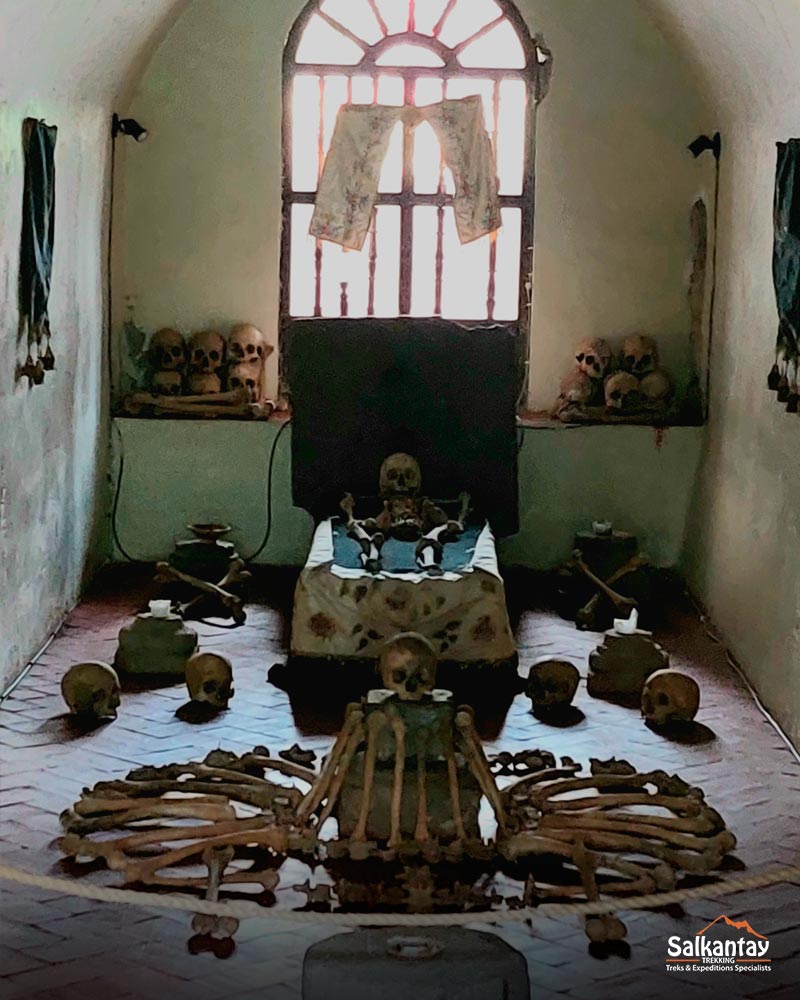

Coricancha Museum
Explore the imposing grandeur of Coricancha, an ancient Inca temple that once served as the Empire’s most significant religious epicenteEmpireerse yourself in the wonder of its meticulously carved walls, delve into the various chambers dedicated to various gods, and admire the imposing presence of the colonial church now standing upon its ancient foundations.
This historic site transports you through the centuries, offering a unique window into the glorious and complex past of the Inca civilization and the subsequent influence of Spanish colonization.
What will you find in this Cusco treasure?
- The Hall of the Sun: This is the heart of Coricancha, dedicated to the god Inti. It is adorned with gold sheets, symbolizing its radiance.
- The Hall of the Stars: Is a space consecrated to celestial deities, where niches that would have housed precious stone ornaments can be appreciated.
- The Hall of the Rainbow: Venerated for its connection to the sun and rain, this chamber would have been covered in gold and adorned with the colors of the rainbow.
- The Hall of Sacrifices: A place where offerings were made, with a stone table where animals were sacrificed, mainly llamas.
- The Hall of Thunder: Is dedicated to Illapa, the god of lightning, one of the most feared and revered deities of the Incan Empire.
- The Empireed Gardens: Beautiful spaces adorned with flowers and shrubs, where offerings were deposited during ceremonies.
- The Sacred Alley: A narrow passage of finely polished stones leading to the Hall of the Sun.
- The Coricancha Site Museum: Exhibits Inca objects found in Coricancha and other archaeological sites in Cusco.
- The Church and Convent of Santo Domingo: This imposing colonial structure is erected on the walls of Coricancha and is adorned with gold leaf and paintings from the Cusco school.
Where is it located?
It is just 1.7 kilometers from Cusco’s Plaza de Armas, at Ahuacpinta Street 659. It is 3,390 meters above sea level.
How to get there?
- Walking: A pleasant 15-minute stroll from Plaza de Armas.
- Taxi: A quick and comfortable ride for approximately 10 Peruvian soles.
History:
- Inca Period: Coricancha was built in the 15th century by the Inca Pachacútec, dedicated to the Sun god and other deities. It was a place of pilgrimage and the scene of important ceremonies.
- Spanish Conquest: In 1533, the Spanish plundered Coricancha and destroyed much of its structure.
- Colonial Period: Upon Inca foundations, the Dominicans erected the Church and Convent of Santo Domingo, which has suffered earthquake damage throughout history.
Practical information:
- Price: Entrance to Coricancha: 15 Peruvian soles. Cusco City Tours: approximately 70 US dollars.
- Hours: Coricancha is open Monday through Saturday from 9:00 a.m. to 6:00 p.m. and Sundays from 9:00 a.m. to 12:00 p.m. The church is free during mass hours.
- Recommendations: Bring identification, comfortable clothing, sunscreen, and a hat.
- Climate: Temperate during the day (22°C) and cold at night (4°C).
- Important Note: Entrance to Coricancha is not included in the Cusco Tourist Ticket.
Additional tips:
- Attend the Inti Raymi reenactment on June 24th.
- Visit the site museum to delve into Inca culture.
- Explore the Church and Convent of Santo Domingo and admire its architecture.
- Enjoy panoramic views from the top of Coricancha.
A visit to Coricancha is essential for anyone exploring Cusco. This emblematic site immerses you in a world of history and culture and captivates you with its architectural splendor and cultural significance. The remnants of the Inca past intertwine with colonial influence, offering a fascinating glimpse into the evolution of this historic city.
The grandeur of its ancestral structures will impress you. Explore the mysteries of its chambers dedicated to Inca deities and marvel at the majesty of the colonial church that rises above this ancient temple. Every corner of this sacred site tells a unique story and invites you to discover the secrets of a lost civilization and the transformation of an era. A visit to Coricancha is an enriching experience that will leave a lasting impression on the memory of all who experience it.

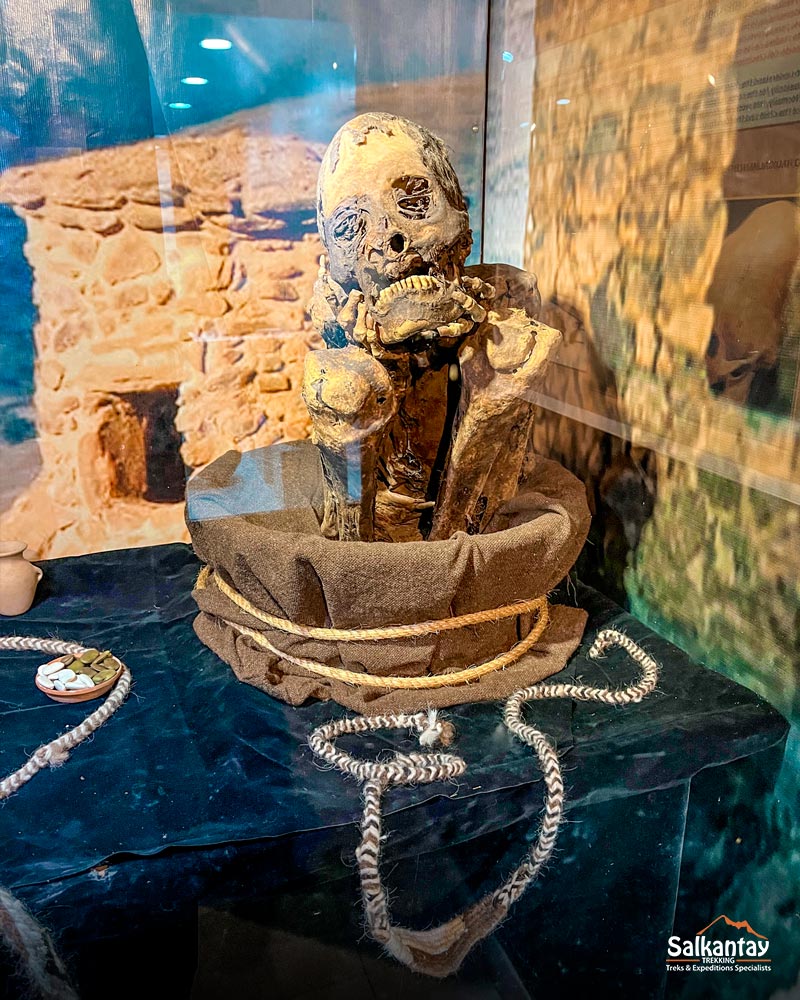












Leave A Reply